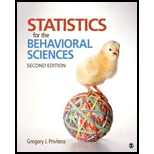
Concept explainers
(a)
Find the test statistic value and make a decision to retain or reject the null hypothesis
(a)
Answer to Problem 32PR
The test statistic value is –3.035.
The decision is to reject the null hypothesis.
Explanation of Solution
Calculation:
A sample of 11children’s each of group is considered and the first group is shaken baby syndrome and without syndrome. The claim is the there is difference between the mean scoresof two groups. This represents the alternative hypothesis. The level of significance is 0.05.
Let
Null hypothesis:
That is, there is no difference between the mean scoresof two groups.
Alternative hypothesis:
That is, there is difference between the mean scoresof two groups.
The degrees of freedom for t distribution is,
The test is two tailed, the degrees of freedom are 10, the level of significance is 0.05.
From the Appendix B: Table B.2 The t Distribution:
- Locate the value 20 in the degrees of freedom (df) column.
- Locate the 0.05 in the proportion in Two tails combined row.
- The intersecting value that corresponds to the 20.0 with level of significance 0.05 is 2.086.
Decision rules:
- If the positive test statistic value is greater than the positive critical value, then reject the null hypothesis or else retain the null hypothesis.
- If the negative test statistic value is less than negative critical value, then reject the null hypothesis or else retain the null hypothesis.
The formula of test statistic for one-sample t test is,
In the formula,
In the formula,
The first group sample size is 11, sample mean is 86.36, and the standard deviation is 15.16. The second group sample size is 11, sample mean is 104.09, and the standard deviation is 12.10.
The pooled sample variance is,
The test statistic value is,
Thus, the test statistic value is –3.035.
Justification: The value of test statistic is –3.035 and critical value is –2.086. The test statistic value is less than the critical value. The test statistic value fall under critical region and hence the null hypothesis is rejected.
(b)
Find the value of estimated Cohen’s d to compute the effect size.
(b)
Answer to Problem 32PR
The value of estimated Cohen’s d is –1.29.
There is large effect size.
Explanation of Solution
Calculation:
Cohen’s d:
The Cohen’s d is the measure to estimate the effect size which is used most frequently for t test. In t test the value of population standard deviation is not known, hence this value is replaced with sample standard deviation for estimation the effect size as,
The Cohen’s d for atwo-independent-sample t test is,
The description of effect size using Cohen’s d:
- If value of Cohen’s d is less than 0.2, then effect size is small.
- If value of Cohen’s d is in between 0.2 and 0.8, then effect size is medium.
- If value of Cohen’s d is greater than 0.8, then effect size is large.
The value of
The absolute value of estimated Cohen’s d is 1.29. This absolute value is greater than 0.8. Hence the estimated Cohen’s d has a large effect size.
However, the value of estimated Cohen’s d is –1.29.
(c)
Find the value of eta-squared to compute the proportion of variance.
(c)
Answer to Problem 32PR
The value of eta-squared is 0.32.
There is large effect size.
Explanation of Solution
Calculation:
Eta-square:
The proportion of variance is measured using eta-square. But eta-square is biased because it over estimates the proportion of variance that is explained by treatment. It is denoted by
In the formula, t is the value of test statistic and df is the corresponding degrees of freedom.
The description of effect size using eta-square:
- If value of eta-square is less than 0.01, then effect size is trivial.
- If value of eta-square is in between 0.01 and 0.09, then effect size is small.
- If value of eta-square is in between 0.10 and 0.25, then effect size is medium.
- If value of eta-square is greater than 0.25, then effect size is large.
The test statistic value is –3.035 and
The value of estimated eta-square is 0.32. This value is greater than 0.25. Hence the eta-square has a large effect size.
Want to see more full solutions like this?
Chapter 9 Solutions
Statistics for the Behavioral Sciences
 Glencoe Algebra 1, Student Edition, 9780079039897...AlgebraISBN:9780079039897Author:CarterPublisher:McGraw Hill
Glencoe Algebra 1, Student Edition, 9780079039897...AlgebraISBN:9780079039897Author:CarterPublisher:McGraw Hill College Algebra (MindTap Course List)AlgebraISBN:9781305652231Author:R. David Gustafson, Jeff HughesPublisher:Cengage Learning
College Algebra (MindTap Course List)AlgebraISBN:9781305652231Author:R. David Gustafson, Jeff HughesPublisher:Cengage Learning


